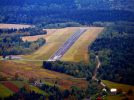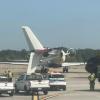Airbus Industries A3ST at Toulouse on Sep 13th 2011, TOGA not TOGA
An Airbus Industries Airbus A300-600 Beluga, registration F-GSTA performing freight flight BGA-1TA from Toulouse (France) to Chester,EN (UK) with 3 crew, was preparing for departure from Toulouse at 114.4 tons of takeoff weight, slats were set to 15 degrees, flaps to 20 degrees and V2 was computed and set at 141 KIAS. The first officer, pilot flying, lined the aircraft up on runway 14R then gradually increased thrust levers and trigged the Go-Levers (TOGA). He then checked the Flight Mode Announciators in agreement with his command, the captain called "FMA indications checked", the flight engineer observed the thrust levers moving into the commanded takeoff position specifically stating that he didn't override them. The aircraft became airborne and the captain selected the gear up, at that occasion he noticed that his flight mode announciator (FMA) no longer showed the expected SRS indication for takeoff, but a THR L (thrust latch) indication in continuous green. His flight director instructed a nose down input. The first officer found his flight mode announciations in agreement with the his commands (showing SRS, flight director commanding climb out pitch). Because of the ínconsistencies between the captain's and first officer's indications the first officer disengaged THR L, which was acknowledged by the FMA now showing MAN THR. The first officer asked the captain to engage autothrust on the flight control unit, the FMAs now showed SPD for the thrust channel and the thrust levers began to retard, the first officer immediately prevented the thrust levers from retarding by pushing them forward and disengaging autothrust. The climb out was continued manually, climbing through 3500 feet autothrust was re-engaged and the flight continued without any further anomalies for a safe landing in Chester.
The French BEA released their final report into the occurrence rated an incident and concluded:
The incident was due to the crew’s failure to detect the non-engagement of the TAKE OFF mode during the FMA check during the take-off run phase. This malfunction probably originated in an erratic failure of the wiring between the Go levers and the FCC1.
The BEA reported that only the quick access recorder (QAR) data were available to the investigation. The QAR recorded the announciations of the left hand system (FCC1) and throttle lever positions, it was not possible to determine the announciations on the right hand side (first officer).
According to the QAR the FMA showed THR L V/S HDG on the incident flight, the thrust levers moved at a rate of 8 degrees/second, while on subsequent flights the FMA showed THR SRS HDGSEL respective THR SRS RWY and the thrust levers moved at 3 degrees/second. The FMA during the incident flight "corresponded to an inactive TAKE OFF mode".
The BEA analyzed that the GO-Lever signal was received by the Thrust Control Computer #1 (TCC1) evident by its engagement in THR L mode. However, the Flight Control Computer #1 (FCC1) did not receive that signal evident by the failure to engage in TAKE OFF mode. The BEA stated: "This anomaly probably came from an erratic failure of the wiring between the Go levers and the FCC1." However, tests were unable to reproduce the anomaly and there was no defect found at the Go-Levers and associated wiring.
The BEA reported in the analysis that another crew, flying the very same aircraft, had observed the same anomaly on May 11th 2011, too, reporting that the FMAs were as expected until after the landing gear was retracted at which point THR L was indicated on both FMAs and the thrust reduced without crew command. A technical analysis following that event was unable to highlight a failure.
The BEA highlighted lessons learned from the event:
"The Captain’s verbal check call out did not include calling out the displayed modes but consisted of calling out “CHECKED”. This check may have been carried out in a routine manner. It proved to be ineffective. "
and
"The speed of movement of the levers, twice as high as that encountered during a normal takeoff, may have drawn the crew’s attention to the ATHR not being engaged in THR mode."
As result of the investigation Airbus decided to modify the flight crew operations manual to include "an operational instruction that will deal with the TAKE OFF mode not being engaged."
The BEA stated: "The QAR data made it possible to reconstruct the modes that were displayed on the left FMA. Their development showed a divergence between the situation described by the crew and that recorded by the QAR. This divergence has not been explained."
http://avherald.com/h?article=46e80053














Komentarze